
Feathers for tying Spey & Dee Flies
Spey patterns such as the Lady Caroline were first developed along the River Spey. They displayed a charactor all their own. The hackling was unique, they used a spey cock side tail or a long heron hackle and the wings were tied from Mallard shoulder.
Later, the Dee-style of tying combined a wing with a long hook, slim body, and long heon hackles. However, it is not only the wing that set these two styles apart, the complexity of the patterns begin to move in the direction of the Victorian era Full Dressed Salmon flies
Lady Caroline
Links to our best selling feathers
Simple and elegant, Spey flies are a favorite among many tiers. The patterns are fun to tie, that is if you have good feathers. Here you will find only the finest feathers, listed in the order - body hackle, feathers for throats, and wings.
 |
Body Hackle Classic Spey dressings called for hackles from the Spey cock, whereas Dee flies were hackled with Heron feathers. A third type, Eagle flies, called for feathers from the leg of a Golden Eagle, however, today they are hackled with marabou blood quills dyed a grey-brown. |
Links
The feathers on these bird most closely resemble the long fibered heron feathers traditionally used to hackle spey patterns. The feathers on the rump have the longest and strongest fibers.
The pulsating movement that these feathers create in the water have made them a popular as a sub. The fibers are long and strong, dye well, and can be found in many contemperary patterns.
Chosen to imitat the soft black shoulder feathers of a heron, the ideal plume has fine stems and fibers with little to no fuzz near the tipps. These blood quills are also ideal for imitating the leg feathers of a Golden Eagle that were used for tying "Eagle flies".
|
The ideal Spey Cock feather is long, thin stemed, and has varing degrees of brownrunning in the feather. Half bronze schlappen is as close as we can come today to immitating the qualities of the rooster bred along the River Spey.
The feathers found on the lower rump of a Ring necked pheasant are heron like in a mannor of speaking, the fibers are long and free of webb. They dye nicely and are a perfect sub for tying mid sized patterns
These feathers are used to hackle heron style flies. They have been put through a slight bleech bath to burn off the barbuals or web that hold the feather together. The feathers vary a bit and the ones with the heavier stems can be split so as to tie in more easily. |
 |
Collars and Throats Classic literature refers to the flank feathers from wigeon, teal, and pintail for use tying throats and collars. Today, tyers have greatly expanded their selection of feathers as well as colors. |
Links
Classic literature refers to wigeon, teal and pintail. However, the flank feathers from any one of the ducks I've listed work well and add their own distinct qualities. To further expand possilbities, check out the dyed colors, and don't be afraid to ask if you don't see one you're looking for.
Often used as a natural substitute for Eropean Jay, these cobalt blue feathers are spoted with robin blue dotts. The fibers are soft and the stem on even the longer feathers is thin and flexable.
There are quite a few different feahers on this bird that are irreplacable in tying spey and dee patterns. The darker feather make the white spots come alive and are great for throats and collars. The electric-blue hackles make nice collars as well, and the long narrow neck hackles are used in tying Elver patterns. |
The vibrant spoted pattern on these feathers make a striking collar. Generally, the larger body feathers have dots that are more distinct and when wraped, create a barred pattern. The dots on the smaller feathers are more blurred. Each lends to its own effect.
The flank feathers on these birds closely resemble lemon flank on a Wood Duck. However, the fibers are much longer and for that reason are especially useful in tying collars on large Dee patterns such as the Glentana. The pattern on the shoulders is nice too! |
 |
Wings Traditionally, Spey fly wings were made of two strips of bronze mallard tied in tent style. Dee flies on the other hand, were made with two slips from turkey quills. Contemperary patterns have added some new and exotic feather to the mix. |
Links
The largest feathers on the flank of a duck are often used as winging material. These include, Hooded Merganser, Pintail, and Green Winged teal, dyed and natural, to name just a few. Flank from exotic waterfowl also sources of interesting possibilities.
Due to it's availability and ease in dying, many tyers use these feathers rather than swan shoulder for tying in Dee-style and Spey-style wings. Goose shoulder is on the soft side and is usually seen tied in "tent-style".
Argus offer three possibilities for winging materials for Dee patterns. Wing feathers, center tail feathers, and side tails. Each have beautiful color patterns and long fibers perfect for tying in V shaped Dee wing styles. The most commonly seen are the snowflake side tails.
The wide, webby, sturdy feathers on a saltwater rooster cape are perfect for hackle tip wings on spey flies. The tips are rounded and the stem is strong so the fly hold its shape in water. These capes are dyed just about any color you could ever want! |
Historically the feather of choice, these feathers used in matched pairs and tied in a roof style. They are the outer shoulder or scapular feathers on a Mallard drake, each having only 3 pair of usable size. Be sure and check out scapular feathers from American Wigeon and Gadwall, the color patterns are interesting.
Historical Dee patterns call for feather strips cut from turkey tails tyed in so when viewed from above, they formed a V shape. Today with all the color mutations of Turkeys being bred there are lots of possibilities. Be sure and check out the dyed color sets.
Not called for that often, these tail quills from the world's largest grouse have a unique mix of irredescent black and white The fibers are long and stiff, perfect for winging materials in Dee patterns. They are used similarily to Turkey tails
|
Ordering
If you'd like to place an order, the best way is to e-mail me a list. If you don't see just the exact color of something you're looking for, or you're just about out of a hard to find color, please ask. Chances are I have one and I'd be glad to email you some pictures.
Soon I hope to have a simple version of a shopping cart, but first I'd like to get most items listed on the site. I'm the only one putting orders together so if you have any special requests I'm glad to help. All orders will be shipped within 24 hours.
Thanks for visiting my site and if you have any questions please call.
David
608-332-4220
 North on the Umpqua
North on the Umpqua
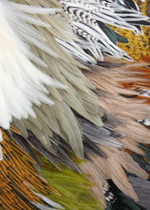
the perfect feather for saltwater and streamer patterns
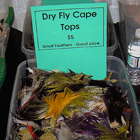
Show Day

Coq de Leon
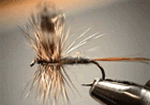
Adams dry fly

Dry Fly Capes
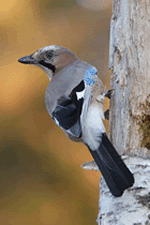
European Jay
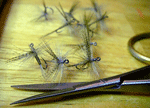
Hendricksons
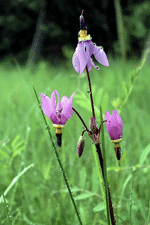
Shooting Star
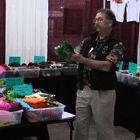
Chuck Furimski shops only the best!


Soft Hackle Hen Capes
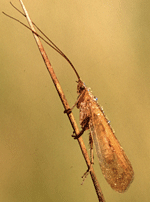
Caddis Fly
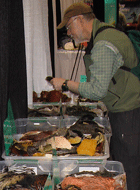
Shopping
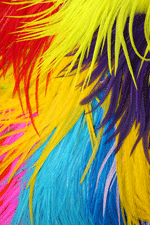
Flat Wing Fly Saddles

True Silver Pheasant
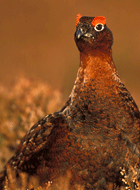
Red Grouse

Mayfly
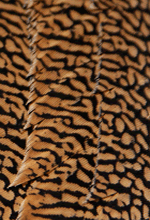
AmGold Tails

Malay Crestless Fireback
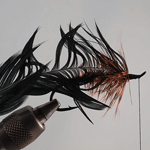
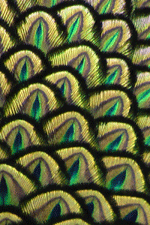
Jave Green Peacock
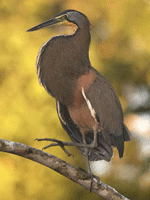
Tiger Heron

Ocelated Turkey

Germain's Peacock Pheasant
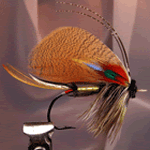
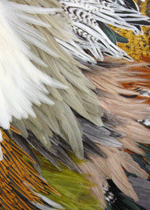
Saltwater Saddles
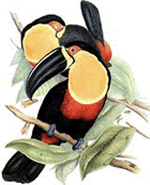
Ariel Toucan

Cotinga
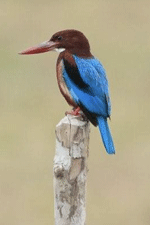
White Breasted Kingfisher
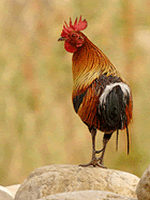
Red Junglefowl

Temmink's Hen
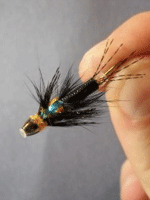
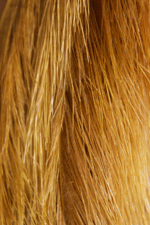
rhea - golden olive


The fin
 Blue Eared Pheasant
Blue Eared Pheasant Rhea
Rhea Marabou Plumes
Marabou Plumes Schlappen
Schlappen Pheasant Rump
Pheasant Rump Burnt Goose Shoulder
Burnt Goose Shoulder Duck Flank
Duck Flank Keyna Crested Guinea
Keyna Crested Guinea Vulurine Guinea
Vulurine Guinea Guinea
Guinea Egyptian Goose
Egyptian Goose Goose Shoulder
Goose Shoulder Argus
Argus Saltwater Rooster
Saltwater Rooster  Bronze Mallard
Bronze Mallard Turkey Tail Quills
Turkey Tail Quills Capercaillie
Capercaillie